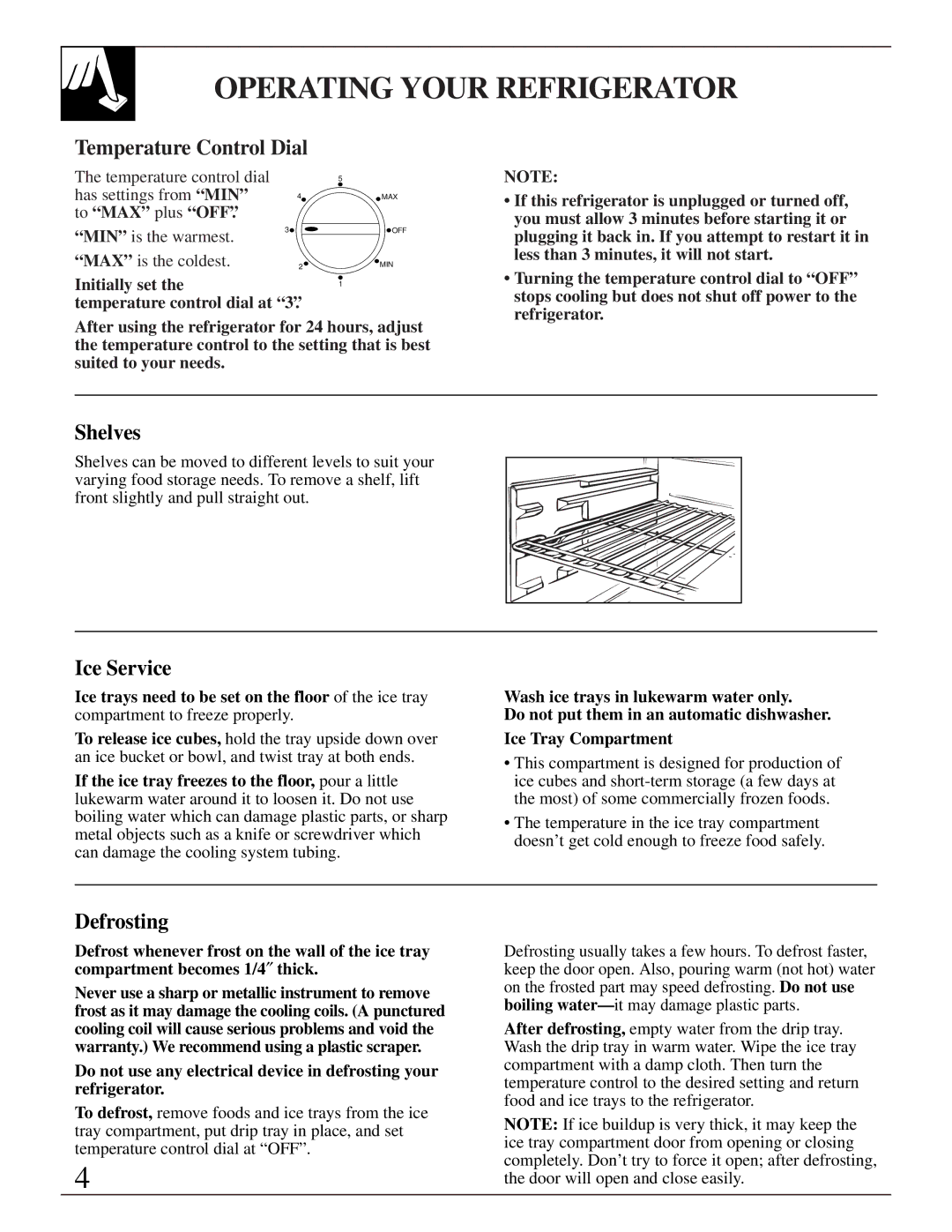
OPERATING YOUR REFRIGERATOR
Temperature Control Dial
The temperature control dial |
| |
has settings from “MIN” | 4 | |
to “MAX” plus “OFF” . |
| |
“MIN” | is the warmest. | 3 |
| ||
“MAX” | is the coldest. | 2 |
Initially set the
temperature control dial at “3” .
5
![]() MAX
MAX
![]() OFF
OFF
MIN
1
NOTE:
•If this refrigerator is unplugged or turned off, you must allow 3 minutes before starting it or plugging it back in. If you attempt to restart it in less than 3 minutes, it will not start.
•Turning the temperature control dial to “OFF” stops cooling but does not shut off power to the refrigerator.
After using the refrigerator for 24 hours, adjust the temperature control to the setting that is best suited to your needs.
Shelves
Shelves can be moved to different levels to suit your varying food storage needs. To remove a shelf, lift front slightly and pull straight out.
Ice Service
Ice trays need to be set on the floor of the ice tray | Wash ice trays in lukewarm water only. | |
compartment to freeze properly. | Do not put them in an automatic dishwasher. | |
To release ice cubes, hold the tray upside down over | Ice Tray Compartment | |
an ice bucket or bowl, and twist tray at both ends. | • This compartment is designed for production of | |
If the ice tray freezes to the floor, pour a little | ||
ice cubes and | ||
lukewarm water around it to loosen it. Do not use | the most) of some commercially frozen foods. | |
boiling water which can damage plastic parts, or sharp | • The temperature in the ice tray compartment | |
metal objects such as a knife or screwdriver which | ||
doesn’t get cold enough to freeze food safely. | ||
can damage the cooling system tubing. | ||
| ||
|
| |
|
|
Defrosting
| Defrost whenever frost on the wall of the ice tray | Defrosting usually takes a few hours. To defrost faster, |
|
| compartment becomes 1/4″ thick. | keep the door open. Also, pouring warm (not hot) water |
|
| Never use a sharp or metallic instrument to remove | on the frosted part may speed defrosting. Do not use |
|
| boiling water— it may damage plastic parts. |
| |
| frost as it may damage the cooling coils. (A punctured |
| |
|
|
| |
| cooling coil will cause serious problems and void the | After defrosting, empty water from the drip tray. |
|
| warranty.) We recommend using a plastic scraper. | Wash the drip tray in warm water. Wipe the ice tray |
|
| Do not use any electrical device in defrosting your | compartment with a damp cloth. Then turn the |
|
| temperature control to the desired setting and return |
| |
| refrigerator. |
| |
| food and ice trays to the refrigerator. |
| |
| To defrost, remove foods and ice trays from the ice |
| |
| NOTE: If ice buildup is very thick, it may keep the |
| |
| tray compartment, put drip tray in place, and set |
| |
| ice tray compartment door from opening or closing |
| |
| temperature control dial at “OFF”. |
| |
| completely. Don’t try to force it open; after defrosting, |
| |
| 4 |
| |
| the door will open and close easily. |
|
